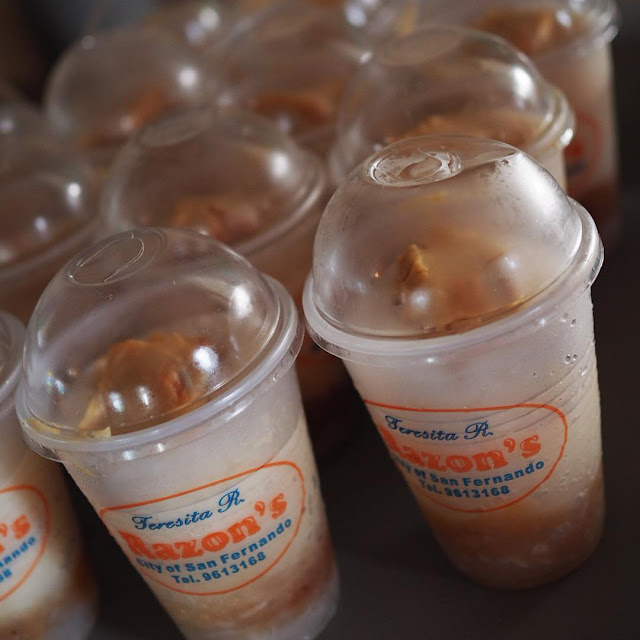I consider QC, particularly the Timog-Morato-Scout area, my ‘hood. I work here so I have plenty of opportunities to try new restaurants nearby. When I do, I am conscientious enough to withhold judgment until the second visit (unless the service is so bad I vow never to go back).
I can name a few stalwarts in the area, places I visit so often I must have already sampled every item on the menu. I can tell you, for example, that
A Taste of LA almost never misses. You should try the callos, osso buco, three-cheese pizza, morconitos,
pritchon,
bistek Tagalog, grilled pork chop and beef fondue. No wonder they’ve lasted this long and are still going strong. I’ve also heard praises for their
sinigang na salmon
sa miso (clear soup with a souring ingredient like tamarind or bilimbi, cooked with salmon and Japanese miso)
but I’m not a
sinigang person.
When it comes to Paella Valenciana and cochinillo,
Alba’s is a no-fail option and the dinner buffet is well priced at P750+. I also have a thing for their coconut macaroons.
If you want Thai, drive without hesitation to
Thaipan and order the soft-shell crab and cinnamon pork ribs. I go to
Cerchio when I’m craving for the salty crunch of their Singaporean crispy squid, and to
Relish just beside it for the roasted chicken. Recently, I went with family to
Alfredo’s, a Tomas Morato institution. The steak is still good, especially if you like it old-fashioned, that is, served on a sizzling plate and ladled with deliciously greasy gravy.
There is not a better time to explore this neighborhood than now when a growing number of vacant ancestral homes are being given a second lease on life as restaurants. One such establishment is
Lola Café-Bar, which I highly recommend. I’ve been there twice prior, and the food made a good impression, but I didn’t realize how consistently good their flavors are until I got to try a wider selection of dishes recently during my brother’s birthday dinner.
Here’s my Lola Café experience:
“I love this. It’s shabby chic,” quipped my nine-year-old niece Julia as we approached our table at the mezzanine while admiring the Mason jar droplights. The walls were adorned with framed quotes in Spanish, Italian and even French. On a wall, a chalkboard menu detailed some of the specials.
Lola Cafe was built in a nicely restored home on Scout Lozano. It maintained the main structure and played it up with vintage furniture and rustic details that added to its charm. Not too shabby, not too chic—a combined quality that also defines its food, which is at once homey and refined. It is real food done real good.
As a starter, we ordered the bone marrow sisig (P230), a new item on the menu. It seemed like a heavy way to start a meal but the serving was small. It came with three crackers and a side of what tasted like tamarind sauce so I allowed myself a small bite. It was certainly novel but I still prefer my marrow on bulalo, which we also ordered (P420).
The kids enjoyed the pesto fries with sunny side up egg so much I only managed to grab three strings.
Of the three appetizers, my favorite was the wagyu salpicao (P320). The meat was tender, arriving in a pool of rich, garlicky sauce.
One thing that Lola has perfected is the making of luscious meat. The kare-kare must have been warming in a bath of peanut-y goodness for hours because the meat was melting. Same can be said about the kimchi kaldereta, which earned the nod of everyone on the table, who loved spooning the sauce over their steamed rice. It’s also hard to find fault with the binagoongang baboy with grilled eggplant.
I also had a taste of my mom’s roasted pork belly and found its mild sweetness a good compliment to the plush belly meat.
The only disappointment was the adobo balsamic chicken, which was my pick. It sounded promising but I found the glaze a tad salty.
Like any other Filipino family, we make it a point to order a noodle dish during birthdays, to signify long life for the celebrant. We made a stellar choice with the tartufo pasta, which was creamy, perfectly seasoned and worth another visit.
Of the three desserts we ordered (they ran out of the pavlova), my vote goes to the banoffee pie, whose graham cracker crust went so well with the creamy custard filling with chunks of banana.
 |
| My niece Julia preparing to attack the cupcake |
|
|
 |
| My foodie family |
 |
| The Menu |
Lola Café-Bar
99 Scout Lozano,
South Triangle, Quezon City
Phone 632-501-2620
Up Next: Saute restaurant

























































